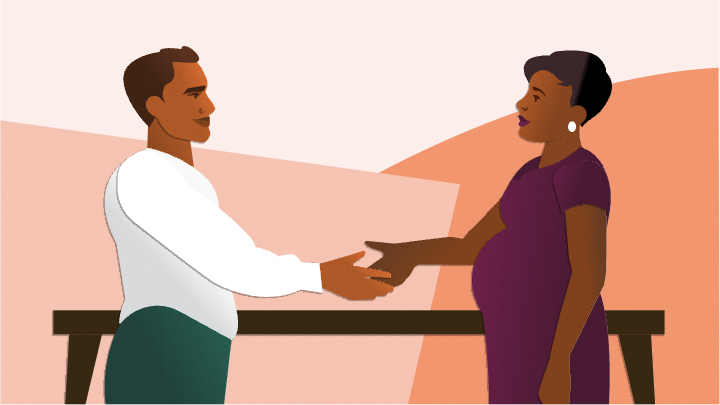How To Create a Presentation Introduction (With Examples)
Updated April 8, 2024
What is a presentation introduction?
A presentation introduction is the first period of a presentation when you inform your audience of who you are and what you’ll be talking about. Your presentation introduction may include visual aids like charts or graphs or a summary about yourself. An introduction should present you as a capable professional and earn your audience’s attention so they want to learn more about your topic.Related: How To Write a Professional EmailHow to create an engaging introduction
Consider using the tips below to engage your audience before your next presentation:1. Tell your audience who you are
Introduce yourself, and then once your audience knows your name, tell them why they should listen to you.Example: ”Good morning. My name is Miranda Booker, and I’m here today to talk to you about how Target Reach Plus software is changing the way businesses manage data for their customers and products.”Related: How To Introduce Yourself in an Interview2. Share what you’re presenting
Tell your audience what you’re going to be talking about in a succinct, organized matter. Think about your content and find three key points you hope to fully explain by the time you’re finished.Example: “I’m here today to talk to you about why Target Reach Plus was created, who’s benefiting from it already and how you can implement this kind of technology in your stores.”3. Let them know why it’s relevant
Your audience needs to know that what you’re presenting is important. Consider pulling in data or statistics to help deliver the importance of your message.Example: “Did you know that 30% of U.S. retailers rely on CustomMax Pro for customer management? By 2030, that number is expected to spike by 15 percent. 45% of those same retailers today using this platform to track sales and marketing efforts still experience slow connection speeds and platform crashes. This is why I urge you to consider adopting Target Reach Plus for your customer management, which already boasts a much lower percentage rate of crashing and sluggishness.”4. Tell a story
Before you start with the slide presentation you organized, consider telling a short, relevant story, as it can help build rapport with the audience. Your story can be humorous, idealistic or thought-provoking, but make it 30 seconds to a minute of relevant information. A personal touch to your story can help too. For example, you might have experienced something personal regarding the main point of your presentation. Let your audience in on that experience.Example: “When I went shopping a few weeks ago with a couple of good friends, I immediately noticed how there are now robots roaming the store and taking orders.”5. Make an interesting statement
If you don’t have a personal story to share with the audience, consider sharing a thought-provoking fact about your presentation’s relevance. If you decide to go forward with this approach, deliver your statement with confidence.Example: It might help to think about delivering this as if you were telling your coworkers or peers about the news you just learned that affects them. You want your audience to know what you’re saying is both truthful and interesting.6. Ask for audience participation
If you don’t plan to make a bold statement or tell a story, ask your audience to participate. The best way to do this is by asking an open-ended question that requires them to either raise a hand or stand up to answer. If it’s early in the morning, try asking them to stand up when they answer your question. This tactic works best in more intimate to small-scale audiences.If you’re unsure of what attention-grabbing tactic will work best, grab a friend, coworker or family member to practice. They can give you feedback on things like your body language, dress attire and, ultimately, what tactic works best with your presentation’s main idea.Related: Character Traits: Definition & ExamplesPresentation introduction templates
The templates below will help you organize your thoughts as you begin to create your presentation introduction.The basic introduction
“Good morning! My name is [insert your name here], and I’m here today to discuss [insert your topic here ]). You will find this interesting because [tie in your audience relevance here].”The attention-grabber
- Bold statement: “Did you know that … [insert a relevant, impactful statistic]?”
- Audience participation: “Stand up today if you believe that… [relevant belief to your topic]”
- Storytelling: “When I think about [topic] it reminds me of when I [personal relevance], and this is so important to [topic] because [pair your experience with the topic].”
Do you need help with your resume?
Good presentation introduction examples
Here are examples for a presentation introduction following the above templates.Example 1: Basic introduction
“Good morning! My name is Tasha, and I’m here today to discuss how 30% of U.S. retailers rely on CustomMax Pro for customer management. Interestingly, did you know that by 2030, that number is expected to spike by 15 percent? As leaders in the retail industry, you want to ensure you’re working smarter rather than harder to manage your customer base.”Example 2: Attention-grabber
- Bold statement: “As leaders in the retail industry, you want to ensure you’re working smarter rather than harder to manage your customer base.”
- Audience participation: “Stand up this morning if you’re eager to learn more about how to gain more customers and track them effectively. Now, introduce yourself to your neighbor and sit back down.”
- Storytelling: “When I worked as a manager in retail, I, of course, felt rewarded with each quality customer relationship we gained. It was challenging, though, to direct the daily workload on top of managing my store’s business. Had I used an effective customer management tool like the one I’m going to tell you about today, I know it would have made an impactful difference.”
Explore more articles
- How to Get an Airframe and Powerplant Mechanic (A&P) License
- How To Hide Rows in Google Sheets in 5 Steps (With Tips)
- How To Calculate a Cumulative Grade Point Average (GPA)
- 20 Ways To Start a Conversation With a Stranger
- What Are Literary Genres? (Plus 16 Types To Try)
- How To Write a Scholarship Recommendation Letter in 7 Steps
- What Is Correlation? (With Definition and Examples)
- 14 Effective Selling Strategies
- 12 Competitive Advantage Examples (Plus Definition)
- How To Make an Email Link in HTML (With Examples)
- What Is Management? Definitions, Functions and Styles
- 13 Types of Graphs and Charts (Plus When To Use Them)


